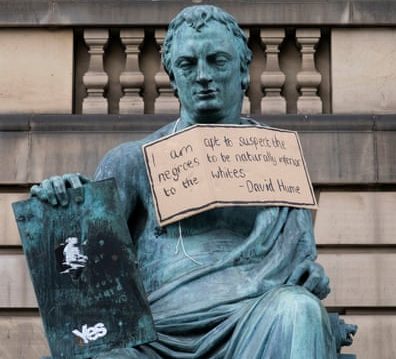The pandemic, which has taken over three million lives and continues to ravage parts of the world; the rise of Trumpism, culminating in the January 6th attack on the Capitol; the degradation of the environment and the threat posed by anthropogenic climate change; these things, and others, have served to alert many of us that the comfort we take in the notion that what has always been the case one’s whole life will always remain the case is nothing more than a pleasant fiction. Several centuries ago, a Scottish philosopher made a similar observation, and notably took it quite a bit further.
May 7th, 2021 marked three hundred and ten years since the philosopher David Hume was born. He is chiefly remembered as the most original and destructive of the early modern empiricists, following John Locke and George Berkeley. As a philosopher, one must admire Hume, even when ultimately rejecting his skepticism about knowledge and certainty. Hume discovered a problem that no one had ever recognized. It is often said, and for good reason, that all of philosophy is a footnote to Plato. Well, Hume laid bare a problem that simply did not exist for the ancients, including Plato. Hume had a moment of true originality, which makes him someone extraordinary in the history of philosophy.
“The Humean predicament is the human predicament,” as W. O. Quine famously quipped. He was undoubtedly referring to Hume’s critique of causality and inductive reasoning. What was the essence of Hume’s critique? Hume saw his critical analysis as effectively undermining any rational grounds for the claim that science discovers universally valid laws of nature. There is no rational justification, according to Hume, for such a claim.
Briefly stated, Hume’s critique runs as follows. Causality – or the cause-effect relation – involves three components. That is, to say A is the cause B, then three things need to be present. The first two are unproblematic: spatial contiguity and temporal priority. The cause has to be spatially adjacent to the effect, and prior to the effect in time. These are unproblematic for Hume, because we have impressions of and encounter them frequently in our experience. But while they are necessary, they are not sufficient: the most important element remains – namely, a necessary connection between cause and effect. Hume’s critique is based on the discovery that we never have an impression of a necessary connection. We never have an experience of causal necessity: the idea of necessary connection is without a corresponding impression; and, for Hume, an idea that cannot be traced back to an impression is nothing more than a fraud.
To make the point clearer: Hume distinguished between two kinds of statements – namely, matters of fact and relations of ideas. When it comes to the relation of ideas, which includes mathematics and logic, we can attain absolute certainty, because an iron logic prevails. But the certainty it yields is purely formal and tells us nothing about the way the world actually is. Matters of fact do tell us about our experience but there is no necessity to be found here: there is no logical contradiction involved in the denial of any matter of fact.
But Hume does not stop there. Why do we believe that nature will continue to behave as it has always behaved? What entitles us to this conviction? We may appeal to the principle of the uniformity of nature — which simply says that the future will resemble the past. But how can we establish the uniformity of nature? It cannot be demonstrated, because there is no logical contradiction involved in its denial; nor can we appeal to past experience as that would be viciously circular. True, in the past the future has resembled the past – that is, past futures resemble past pasts, but that does not mean that future futures will resemble future pasts. In the past, the future has resembled the past — but there is an unjustifiable leap from there to the claim that in the future the future will resemble the past.
Shocking as it may (and should) sound, Hume is implying nothing less than that the next time you turn the key in your car ignition, you are as justified to expect the engine will start as you are in believing it will turn into a pumpkin. For there is a radical contingency that pervades all our experience. We could wake up tomorrow to a world that looks and behaves very differently to the one we are in now. Matters of fact are dependent on experience and can never be known a prior — they are purely contingent, and could always turn out different than what we expect.

It is a testament to Hume’s greatness that his analysis can support very different interpretations and conclusions. Consider Quentin Meillassoux’s notion of Divine Inexistence: For Meillassoux, the advent of the divine is possible – that is to say, God is possible. But this is not because it is possible that God might exist at present. Rather, what he means is that God may come to exist in the future. God ‘inexists’ – that is, he happens not to exist at present, but God’s possible existence is necessary.
Divine Inexistence means first that there is no God extant (no metaphysical principle or creator of the world). But Divine Inexistence also means that what remains still in a virtual state in present reality harbors the possibility of a God still to come.
A God that is yet to come would also be innocent of the disasters of the world. In short, we are permitted to hope for a God who does not yet exist and hence is not responsible for the atrocities of history, but who may come to exist in the future and resurrect the dead.
In proposing the theory of Divine Inexistence, Meillassoux draws on David Hume – starting from Hume’s skeptical doubt as to the necessity of causal relations. Neither the logician, nor the scientist can establish the necessity of the causal connection – that is, neither can prove that it is necessary that the same effects should always follow from the same causes. The idea of necessary connection is not derived from rational self-evidence, nor is it derived from empirical sense impressions.
Objects have no discernable connection together, nor is it from any principle but custom that we draw inference from one to the other. For Hume, a cause is nothing more than an object in constant spatial and temporal conjunction with another, such that the experience of the one compels the mind to expect the other.
Meillassoux observes that it is possible to draw very different conclusions from the same premises. For rather than conceding that reason cannot prove causal necessity a priori, why not affirm that reason reveals that all causal relations are contingent, that it opens up the possibility that in the future completely different effects could follow from exactly the same causes?
Accordingly, in proposing the notion of Divine Inexistence, Meillassoux appeals to his Humean argument that the laws of nature can change at any moment for any or no reason whatsoever. G. K. Chesterton, like Meillassoux, avoids the skeptical conclusions to which Hume’s critical analysis of causality is supposed to lead. Chesterton certainly takes a page from Hume when he observes that “learned men in spectacles were talking of the actual things that happened – dawn and death and so on – as if they were rational and inevitable. They talked as if the fact that trees bear fruit were just as necessary as the fact that two and one trees makes three. But it is not.”
When it comes to matters of fact, or the observations of scientific method, Chesterton refuses to give the word ‘law’ and instead speaks of ‘weird repetitions’ (Hume calls them ‘constant conjunctions’). But Chesterton derives a very different lesson from Hume. To see the world is to wonder at it. Life itself has the character of a fairy-tale – it has a telos, an entelechy, we feel ourselves to be part of a story. There is something personal in the world as in a work of art.
In Meillassoux’s rendering of Hume, God is yet-to-be. In Chesterton’s appropriation of Hume, God is calling every morning on the sun for a theatrical encore: “God says ‘Do it again’ to the sun and every evening ‘Do it again’ to the moon.” Meillassoux emphasizes that at any moment everything may become utterly strange and foreign. Chesterton underscores how strange and enchanted the world already is. “Water runs downhill because it is bewitched.”
There is nothing mystical about any of this. For Chesterton, one who insists on some law connecting, say, trees and fruit is the real mystic or the dreamy-eyed sentimentalist. Seeing the world as enchanted, Chesterton is paradoxically perhaps the true realist because he is remaining true to our actual experience, in which we can find no logical connection whatever between trees and fruit, or flames and heat for that matter.
The greatness of Hume lies not in the skeptical conclusions he arrived at, but the wholly original considerations which allowed him to get there. Hume’s critique of causality has the ability, at the very least, to defamiliarize the world, and in that sense to potentially re-enchant it, to enable us to see that the world has indeed the structure of a fairy-tale. There is an aesthetic comprehension of the natural world that makes a genuinely scientific grasp of it possible. If we are not seeing the world as a work of art, then we are not seeing it scientifically.
Sam Ben-Meir is a professor of philosophy and world religions at Mercy College in New York City.











